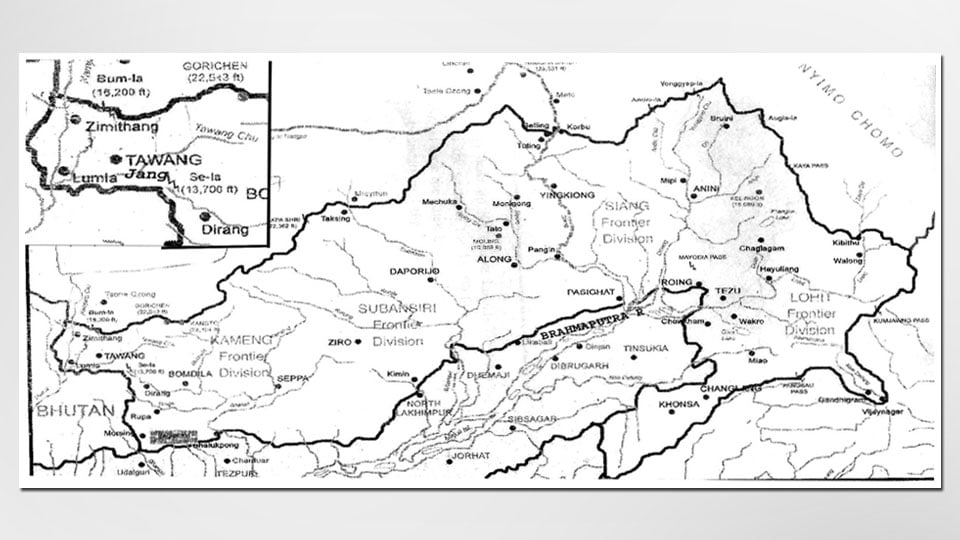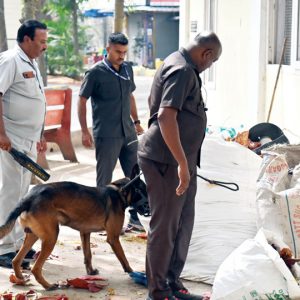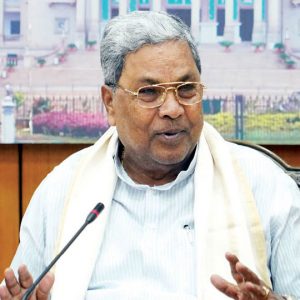In the context of Dalai Lama’s recent visit to Tawang and Bomdila
By U. B. Acharya
Preamble
On 20th October 1962, we the students living in the hostel heard the news that in the early hours of that morning, Chinese forces had run over our positions along the NEFA (now Arunachal Pradesh) border killing several of our jawans and junior officers. For the next one month all of us were glued to the common room’s radio listening to the hourly news bulletins of BBC. We literally wept when we heard the news of successive army positions in NEFA run over by the advancing forces or evacuated voluntarily by our commanders leaving the dead and the wounded to fend for themselves.
By 19th November, the Chinese forces had occupied Tawang and Bomdila and were on the foothills ready to run over the whole State of Assam. Surprisingly, China declared unilateral cease-fire from 20th November, and in fact withdrew to the pre 20th October position! It was no doubt an utter and humiliating defeat of India by the belligerent China.
In order to know the genesis, we need to dig deep into the history of India during the British Raj as well as the first 15 years of independent India.
India under the British Raj
The British having annexed the entire country were protective of their boundaries. They would either limit their boundary which they could defend easily or have a buffer country between them and the more powerful enemy. In the North-West, Afghanistan was the buffer country between India and Imperial Russia. In the North, the boundary of Kashmir and Ladakh (which included the Aksai Chin) was itself a formidable boundary.
In the North-East sector, the Himalayas were a natural boundary. Beyond the Himalayas was a vast country of Tibet, an independent country under the leadership of the Dalai Lama. But Britain cunningly let the eastern portion of Tibet be under Chinese control and keep the western portion facing India under its control. The boundary line (the watershed line called the McMahon Line) between India and Tibet was agreed in Simla Conference in 1914. Unfortunately, this line was never demarcated and also near the tri-junction of Tibet-Bhutan-India, there were some errors.
Tawang monastery had always been under the control of Tibet though it was south of the Himalayan watershed. Tibet secretly agreed to give up this area to British India in exchange of 5,000 Lee Enfield rifles and 500,000 rounds of ammunition (to be used against China). Chinese have never been able to accept this loss of Tawang.
Independent India: 1947-1958
India achieved its independence in 1947 and the army was divided between India and Pakistan. Before India could replenish the army, Kashmir conflict started. The history of Kashmir conflict of 1948 will not be repeated here but suffice is to say that India has been maintaining a substantial army along the Line of Control and also inside Kashmir but neglected the border with China.
During the 1950s, the budget for the military was progressively reduced because of the five-year plans and other nation-building projects. Also among the top politicians and bureaucrats, there was an inherent fear that military might take over the government and so they were suppressed.
Chinese Expansion Policy
In 1949, Mao Tse-tung’s Communists defeated the army of Gen. Chiang Kai-shek’s government. Mao then boldly annexed Sinkiang in 1950 and also annexed the portion of Tibet (which was autonomous under the British control but passed on to India) in 1951. Though USA and Britain protested this move, India strongly supported China and accepted Chinese control over Tibet. It turned out later that this was the biggest folly of Nehru.
A study of the map would indicate that Aksai Chin protruded like a wedge between Sinkiang and Tibet. Prior to 1947, Kashmir State Forces regularly guarded the entire Aksai Chin. Post liberation of Kashmir, this practice was discontinued. Absence of Indian military presence in Aksai Chin made it a low hanging fruit for China.
And in 1955, China boldly started building a road (roughly N-S) across Aksai Chin and they completed the road construction by 1958. As Nehru was on a grand “Non-Alliance” movement, “Panch-Sheel” and “Hindi-Chini Bhai Bhai” mode, Chou En-lai was confident that Nehru could be persuaded to accept it. Having constructed the road, the Chinese then stationed troops to protect it.
During this period, Chinese official maps were showing not only Aksai Chin (39,000 sq kms) but also the entire NEFA (83,000 sq kms) as parts of China. When India took this matter up, China just brushed aside by saying that these maps were from the old regime and they had not yet updated them!
India: 1958-1962
When India woke up to this fait accompli, it was not in a position to challenge the intrusion. On top of this, the press and the opposition were at the throat of the Government. Nehru initially denied in the Parliament that there was any Chinese intrusion but when Chinese press announced the grand opening of the road, he had to admit this fact. He then took up the line that the Indian army was capable of throwing the Chinese out of our territory. Thanks to the step-motherly treatment of the army, they were just not in a position to accomplish this.
Chinese meanwhile were willing to negotiate provided they keep the area under their control (that is, Aksai Chin) and India keeps the area under its control (that is, NEFA) with minor boundary adjustments. As this was not acceptable to India, it thought of a “Forward Policy” where Indian army was asked to establish army outposts all along the Chinese claim line and in some places inside Chinese claimed territory.
Unfortunately, Indian military infrastructure (like rail head, roads, dropping zones, arms and ammunition, winter clothing, etc.) were just not adequate to successfully implement this policy. Apart from the thin first line of offence, there was no second or third line of proper fortification. With the implementation of the forward policy, the point of collision was reached but India (read Nehru, Menon, Intelligence head Mullick and Nehru’s blue eyed army officer Lt. Gen. B.M. Kaul) was still confident that in this game of chicken, China would buckle under!
While arguments and counter arguments were heating up, in 1959 there was an internal rebellion against China in Tibet led by Dalai Lama. This was crushed by China and Dalai Lama had to escape to India in disguise via the Tawang tract. China demanded that India return Dalai Lama to them, but India refused. During the same year, there were two minor skirmishes in NEFA border and one in Ladakh Area. In all these cases, Chinese had the upper hand.
India China War
10th Oct. to 19th Nov., 1962
The gory details of the war will not be discussed here but suffice is to say that our attempt to force the Chinese out from the Thagla Ridge (near the tri-junction of China-India-Bhutan borders) on 10th of October 1962 sparked the conflict. Then on 20th October morning Chinese troops opened multiple fronts at Aksai Chin as well as at NEFA. While there was some fighting in Aksai Chin front and in Walong sector of NEFA, there was full retreat in Thagla-Tawang-Bomdila sector. By 18th November, the army had retreated beyond Bomdila. Let down by its senior officers, the Indian Army and the people of Assam now lay at the mercy of Chinese.
In the final countdown, India had lost nearly 3,000 soldiers dead or missing and about 4,000 soldiers taken prisoners. Though we were supposed to have killed a few hundred Chinese soldiers, we did not capture a single POW.
Aftermath & Ultimate Analysis
In the confusion of the immediate aftermath of the ceasefire, the spotlight was obviously on the higher levels of the command. In the history of modern warfare, it is doubtful if there are any Generals at the top of a command pyramid who have displayed such collective incompetence. The jawans, JCOs and junior officers bewildered by the turn of events and trusting in their commanding officers can hardly be faulted. YET IT WAS THEY WHO HAD TO COLLECTIVELY PAY THE PRICE.
Though the top political plus bureaucratic leadership and the senior most army Generals are responsible for the debacle, ultimately Nehru has to take the blame. While Menon was forced to resign, Nehru continued as PM till his death in May 1964. Many senior Generals, instead of court marshaled and summarily sacked, were allowed to continue.
Way Forward
Even after 54 years, the position remains the same on the ground. Unless some very fundamental changes occur internally in China, it would be impossible for India to reclaim the Aksai Chin territory. Even today, Chinese maps show the entire Arunachal Pradesh as their territory. Meanwhile, Dalai Lama continues to remain in exile in India.
As Chinese GDP is considerably higher than India’s, New Delhi may be a distant speck in Beijing’s rear view mirror. It will only begin to respect India’s concern if it sees that speck in its rear view mirror grow larger. To that to happen, India’s economy must grow faster than that of China. This is possible by solving the Kashmir problem, by removing all the internal security issues and by bringing about complete national unity. Also political and bureaucratic corruption would have to disappear. In addition, our relationship with all the neighbouring countries such as Nepal, Bhutan, Sri Lanka, Myanmar, Malaysia, Indonesia, Philippines, South Korea and Japan must improve dramatically. All these may be a distant dream.
Under this climate, Dalai Lama’s visit to Tawang monastery in April 2017 is very significant. China strongly protested this visit and even threatened India. His successful visit is in fact a minor diplomatic victory to India. India needs to do much more than this to pressurise China.
About the Author
The author has worked as an oil executive in NE Assam and Eastern Arunachal Pradesh just after the war and has met a number of civilians and army personnel involved in this conflict. This article is based on his discussions with them and on the available literature on this subject. Conclusions arrived in this article are his personal views with no malice to anybody. —Ed.








Recent Comments